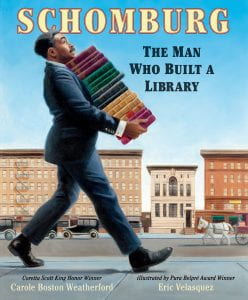 In luminous paintings and arresting poems, two of children’s literature’s top African-American scholars track Arturo Schomburg’s quest to correct history. Where is our historian to give us our side? Arturo asked. Amid the scholars, poets, authors, and artists of the Harlem Renaissance stood an Afro–Puerto Rican named Arturo Schomburg. This law clerk’s life’s passion was to collect books, letters, music, and art from Africa and the African diaspora and bring to light the achievements of people of African descent through the ages. When Schomburg’s collection became so big it began to overflow his house, he turned to the New York Public Library, where he created and curated a collection that was the cornerstone of a new Negro Division. A century later, his groundbreaking collection, known as the Schomburg Center for Research in Black Culture, has become a beacon to scholars all over the world. Ages 9–12.
In luminous paintings and arresting poems, two of children’s literature’s top African-American scholars track Arturo Schomburg’s quest to correct history. Where is our historian to give us our side? Arturo asked. Amid the scholars, poets, authors, and artists of the Harlem Renaissance stood an Afro–Puerto Rican named Arturo Schomburg. This law clerk’s life’s passion was to collect books, letters, music, and art from Africa and the African diaspora and bring to light the achievements of people of African descent through the ages. When Schomburg’s collection became so big it began to overflow his house, he turned to the New York Public Library, where he created and curated a collection that was the cornerstone of a new Negro Division. A century later, his groundbreaking collection, known as the Schomburg Center for Research in Black Culture, has become a beacon to scholars all over the world. Ages 9–12.
About The Author
 The daughter of educators, award-winning poet Carole Boston Weatherford began writing in first grade. Today she is the author of numerous books, including the Carter G. Woodson award winning title, The Sound That Jazz Makes and most recently, Dear Mr. Rosenwald. Her writing covers such topics as jazz and photography, as well as the slavery, reconstruction and Jim Crow eras. When she’s not traveling or visiting museums, Carole is mining the past for family stories, fading traditions, and forgotten struggles. Coming from a family of educators, she has a passion for rescuing events and figures from obscurity by documenting American history. A Fayetteville State University professor, Carole lives with her husband, son, and daughter in High Point, North Carolina.
The daughter of educators, award-winning poet Carole Boston Weatherford began writing in first grade. Today she is the author of numerous books, including the Carter G. Woodson award winning title, The Sound That Jazz Makes and most recently, Dear Mr. Rosenwald. Her writing covers such topics as jazz and photography, as well as the slavery, reconstruction and Jim Crow eras. When she’s not traveling or visiting museums, Carole is mining the past for family stories, fading traditions, and forgotten struggles. Coming from a family of educators, she has a passion for rescuing events and figures from obscurity by documenting American history. A Fayetteville State University professor, Carole lives with her husband, son, and daughter in High Point, North Carolina.
Read Aloud Tips
- Create a reading theme around the author, who has published many social justice titles. Read her bio and have students make similarities between her books. Use the author’s note to introduce slavery and incorporate into a bigger unit.
- Using conversation slips and debate centers, ask students to discuss why it is important to have literature that represents all Americans. Additionally, have them talk about a book or story that they truly connected with and why.
“All of the book’s details paint Schomburg as an admirable, flawed, likable, passionate man whose lasting legacy, Harlem’s Schomburg Center for Research in Black Culture, opens its doors to all who would learn more about the people its founder knew had been left out of the written record. A must-read for a deeper understanding of a well-connected genius who enriched the cultural road map for African-Americans and books about them.” – Kirkus Reviews